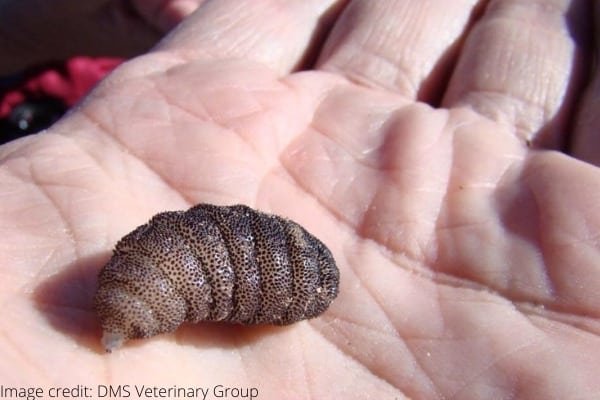
**Wolf worms, or Cuterebra, are a type of fly larvae that can hitch a ride on your pets**—especially cats and dogs—when they wander into the wrong places. These parasites might not be the first thing that comes to mind when you’re playing fetch or snuggling on the couch, but understanding their life cycle and identifying the signs of an infestation can be critical to keeping your furry companion healthy. Let’s walk through the details together.
What Are Wolf Worms?
Wolf worms are the larvae of the Cuterebra flies, and while they sound scary, they are a natural part of the ecosystem. The female flies lay their eggs near burrows or areas where small mammals like rabbits and rodents live. When the eggs hatch, the larvae wait for a host to come by—often a curious cat or dog. Once they attach to a pet, they burrow into the skin, leading to potential health problems.
You might be wondering why they’re called wolf worms. It’s actually due to their association with wild canids, like wolves. However, they don’t discriminate! Any pet that spends time outdoors can inadvertently become a host. Recognizing the signs early can mean the difference between a small inconvenience and a serious health issue.
Common Signs of Wolf Worm Infestation
One of the challenges with a wolf worm infestation is that early symptoms can be subtle. However, there are a few telltale signs you might notice in your outdoor pets:
- Swelling or lumps: You might find small lumps on your pet’s body that may look like abscesses. These are areas where the larvae are buried under the skin.
- Excessive scratching: If your pet seems to be scratching or biting at a particular spot more than usual, it could be due to irritation from the lurking larvae.
- Change in behavior: Your pet might seem more uneasy or lethargic if they have an infestation. This discomfort can lead to mood changes.
- Discharge: Sometimes, infected areas may ooze or even bleed, typically when they become inflamed.
If you notice any of these symptoms, it’s best to consult your veterinarian. They can help confirm whether wolf worms are the issue and guide you through the next steps.
How Do Pets Get Infected?
Understanding how pets get infected can help you take preventative measures. The life cycle of wolf worms typically unfolds like this:
1. **Eggs are laid:** Female Cuterebra flies lay their eggs near rabbit holes or areas where rodents live.
2. **Hatching:** When the eggs hatch, the young larvae await a host. They may be attracted to heat and carbon dioxide emitted by animals.
3. **Burrowing:** Once they find a suitable host like a dog or cat, they attach and burrow into the skin. This can often happen unnoticed.
4. **Growth:** Inside the host, the larvae will mature, which can take several weeks before they emerge and continue their life cycle.
The whole process can seem like a horror movie plot, but awareness is the key! If your pet loves to dig or roll around in the grass, you’re going to want to keep a keen eye on them.
Preventing Wolf Worm Infestations
The good news is that you can take steps to minimize the risk of wolf worm infestations. Here are some practical tips:
- Regular grooming: Keep your pet’s coat clean and well-groomed. This not only helps you spot anything unusual but also reduces the chance of larvae being missed.
- Limit outdoor exposure: If you live in an area known to harbor wolf worms, consider limiting your pet’s time in certain areas, especially during the peak months of summer.
- Routine check-ups: Regular vet visits can help catch any potential problems early on. Your vet can guide you on the best practices for your specific area.
Implementing these measures can go a long way in keeping your furry friend safe. Plus, you can enjoy those outdoor adventures without worrying as much!
Treatment Options for Infected Pets
If you suspect your pet is dealing with a wolf worm infestation, it’s crucial to seek veterinary care as soon as possible. Treatment varies based on the severity of the infestation. Your vet may recommend:
– **Surgical removal:** In many cases, the larvae can be surgically removed. This is usually a straightforward procedure.
– **Antibiotics:** If the site of the infestation is infected, your vet might prescribe antibiotics to help with healing.
– **Pain management:** Often, your pet may need medication to alleviate any discomfort during recovery.
After treatment, keep a close eye on the affected area. You want to ensure that your pet heals properly and doesn’t develop any complications.
When to Seek Veterinary Help
Timing can be everything when it comes to wolf worm infestations. If you notice any signs of infestation or if you suspect your pet may have come into contact with areas where wolf worms are common, don’t hesitate to reach out to your vet. Here are some key indicators for immediate veterinary help:
- Development of new lumps or swelling.
- Signs of pain or distress in your pet.
- Discharge from any wounds or areas of concern.
The earlier you act, the better the outcome for your pet. Remember, your vet is your partner in keeping your pet healthy and happy.
In summary, being aware of wolf worm infestations is essential for every pet owner, especially those with outdoor-loving companions. By understanding what wolf worms are, how to identify them, and what preventive measures can be taken, you can significantly reduce the risk of infestation. Keeping an eye out for symptoms and seeking veterinary help promptly can make all the difference in your pet’s well-being.
Being a pet owner often feels like being a detective—always on the lookout for clues that might suggest something’s not quite right. As you embark on outdoor adventures with your furry friend, remember that knowledge is your best tool. Enjoy your time outside, knowing you’re well-equipped to handle any surprises!
